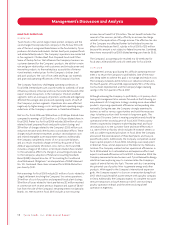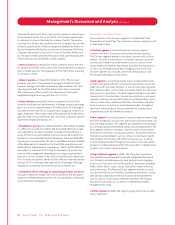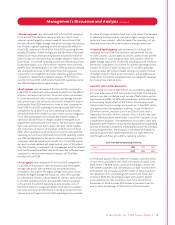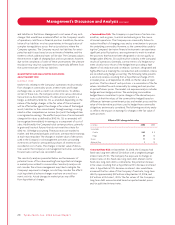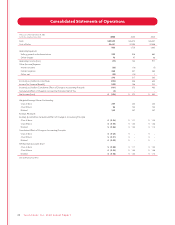Tyson Foods 2006 Annual Report Download - page 22
Download and view the complete annual report
Please find page 22 of the 2006 Tyson Foods annual report below. You can navigate through the pages in the report by either clicking on the pages listed below, or by using the keyword search tool below to find specific information within the annual report.
and liabilities in the future. Management is not aware of any such
changes that would have a material effect on the Company’s results
of operations, cash flows or financial position. In addition, the calcu-
lation of tax liabilities involves uncertainties in the application of
complex tax regulations across the tax jurisdictions where the
Company operates. The Company records tax liabilities for antici-
pated tax audit issues based on our estimate of whether, and the
extent to which, additional taxes will be due. The Company adjusts
these reserves in light of changing facts and circumstances; however,
due to the complexity of some of these uncertainties, the ultimate
resolution may result in a payment that is materially different from
the current estimate of the tax liabilities.
QUANTITATIVE AND QUALITATIVE DISCLOSURE
ABOUT MARKET RISK
MARKET RISK
Market risks relating to the Company’s operations result primarily
from changes in commodity prices, interest rates and foreign
exchange rates, as well as credit risk concentrations. To address
certain of these risks, the Company enters into various derivative
transactions as described below. If a derivative instrument is a
hedge, as defined by SFAS No. 133, as amended, depending on the
nature of the hedge, changes in the fair value of the instrument
will be offset either against the change in fair value of the hedged
assets, liabilities or firm commitments through earnings, or recog-
nized in other comprehensive income (loss) until the hedged item
is recognized in earnings. The ineffective portion of an instrument’s
change in fair value, as defined by SFAS No. 133, as amended, will
be recognized immediately in earnings as a component of cost of
sales. Additionally, the Company holds certain positions, primarily
in grain and livestock futures that do not meet the criteria for
SFAS No. 133 hedge accounting. These positions are marked to
market, and the unrealized gains and losses are reported in earnings
at each reporting date. The changes in market value of derivatives
used in the Company’s risk management activities surrounding
inventories on hand or anticipated purchases of inventories are
recorded in cost of sales. The changes in market value of deriva-
tives used in the Company’s risk management activities surrounding
forward sales contracts are recorded in sales.
The sensitivity analyses presented below are the measures of
potential losses of fair value resulting from hypothetical changes
in market prices related to commodities. Sensitivity analyses do
not consider the actions management may take to mitigate the
Company’s exposure to changes, nor do they consider the effects
such hypothetical adverse changes may have on overall eco-
nomic activity. Actual changes in market prices may differ
from hypothetical changes.
• Commodities Risk: The Company is a purchaser of certain com-
modities, such as grains, livestock and natural gas in the course
of normal operations. The Company uses commodity futures to
reduce the effect of changing prices and as a mechanism to procure
the underlying commodity. However, as the commodities underly-
ing the Company’s derivative financial instruments can experience
significant price fluctuations, any requirement to mark-to-market
the positions that have not been designated or do not qualify as
hedges under SFAS No. 133 could result in volatility in the Company’s
results of operations. Generally, contract terms of a hedge instru-
ment closely mirror those of the hedged item providing a high
degree of risk reduction and correlation. Contracts designated and
highly effective at meeting this risk reduction and correlation criteria
are recorded using hedge accounting. The following table presents
a sensitivity analysis resulting from a hypothetical change of 10%
in market prices as of September 30, 2006, on the fair value of open
positions. The fair value of such positions is a summation of the fair
values calculated for each commodity by valuing each net position
at quoted futures prices. The market risk exposure analysis includes
hedge and non-hedge positions. The underlying commodities
hedged have a correlation to price changes of the derivative posi-
tions such that the values of the commodities hedged based on
differences between commitment prices and market prices and the
value of the derivative positions used to hedge these commodity
obligations are inversely correlated. The following sensitivity analy-
sis reflects the impact on earnings for changes in the fair value of
open positions.
Effect of 10% change in fair value
in millions 2006 2005
Livestock:
Cattle $43 $ 3
Hogs 37 13
Grain 11 15
Natural Gas 112
• Interest Rate Risk: At September 30, 2006, the Company had
fixed-rate, long-term debt of $3.4 billion with a weighted average
interest rate of 7.4%. The Company has exposure to changes in
interest rates on this fixed-rate, long-term debt. Market risk for
fixed-rate, long-term debt is estimated as the potential increase
in fair value, resulting from a hypothetical 10% decrease in interest
rates. A hypothetical 10% decrease in interest rates would have
increased the fair value of the Company’s fixed-rate, long-term
debt by approximately $87 million at September 30, 2006, and
$47 million at October 1, 2005. The fair values of the Company’s
long-term debt were estimated based on quoted market prices
and/or published interest rates.
20 Ty s on Foods, Inc. 2006 Annual Report
Management’s Discussion and Analysiscontinued


